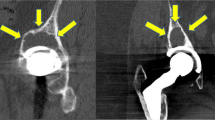Abstract
Cementless acetabular components gained popularity because of the increased rate of loosening associated with cemented cups after intermediate and long-term follow-up. There are few long-term follow-up studies of cementless acetabular components. This study aims to evaluate the clinical and radiological long-term results of the press-fit standard Wagner Cup. Between January 1, 1994 and June 30, 1994, 118 implantations of a standard Wagner Cup were performed, and 102 implants were clinically and radiographically followed-up after a mean of 12.0 years. The Merle d’Aubigné score improved from a preoperative mean of 9.5 to 17.2 at latest follow-up. Early postoperative complications included two deep haematomata requiring needle aspiration, two deep vein thromboses, one pulmonary embolism, two temporary lesions of the sciatic nerve, one single event of THR dislocation and one recurrent dislocation. Two isolated cup revisions and five more complete total hip replacements were performed for aseptic loosening. The overall survival rate at 12 years was 93.1% (95/102). The standard Wagner cup yields very good long-term results.



Similar content being viewed by others
References
Archibeck MJ, Berger RA, Jacobs JJ, Quigley LR, Gitelis S, Rosenberg AG, Galante JO (2001) Second-generation cementless total hip arthroplasty. Eight to eleven-year results. J Bone Joint Surg Am 83-A:1666–1673
Clohisy JC, Harris WH (1999) The Harris-Galante porous-coated acetabular component with screw fixation. J Bone Joint Surg Am 81-A:66–73
Crowther JD, Lachiewicz PF (2002) Survival and polyethylene wear of porous-coated acetabular components in patients less than fifty years old. J Bone Joint Surg Am 84-Am:729–735
Engh CA Jr, Culpepper WJ, Engh CA (1997) Long-term results of use of the anatomic medullary locking prosthesis in total hip arthroplasty. J Bone Joint Surg Am 79-Am:177–184
Engh CA, Hopper RH Jr, Engh CA Jr (2004) Long-term porous-coated cup survivorship using spikes, screws, and press-fitting for initial fixation. J Arthroplasty 19(Suppl 2):54–60
Farizon F, de Lavison R, Azoulai JJ, Bousquet G (1998) Results with a cementless alumina-coated cup with dual mobility. A twelve-year follow-up study. Int Orthop 22:219–224
Harris WH (2001) Wear and periprosthetic osteolysis. Clin Orthop 393:66–70
Hsu JT, Chang CH, An KN, Zobitz ME, Phimolsarnti R, Hugate RR, Lai KA (2007) Effects of screw eccentricity on the initial stability of the acetabular cup. Int Orthop 31:451–455
Huo MH (2002) What’s new in hip arthroplasty. J Bone Joint Surg Am 84-Am:1894–1905
Jasty M, Goetz DD, Bragdon CR, Lee KR, Hanson AE, Elder JR, Harris WH (1997) Wear of polyethylene acetabular components in total hip arthroplasty. J Bone Joint Surg Am 79-Am:349–358
Kim YH, Kim JS, Cho SH (1999) Primary total hip arthroplasty with a cementless porous-coated anatomic total hip prosthesis. J Arthroplasty 14:538–548
Levine B, Weisz R, Kubiak E, Testa NN (2005) Long-term radiographic evaluation of Trilock press-fit acetabular components in primary total hip arthroplasty. Bull Hosp Jt Dis 62:115–120
Nakoshi Y, Hasegawa M, Sudo A, Uchida A (2008) A long-term follow-up study of the cementless THA with anatomic stem/HGPII cup with 22-mm head. Int Orthop. OnlineFirst Jan 9
Russell RC, Ghassemi A, Dorrell JH, Powles DP (2008) The bimetric cementless total hip replacement: 7–18 year follow-up assessing the influence of acetabular design on survivorship. Int Orthop. OnlineFirst Jun 13
Smith SE, Estok DMII, Harris WH (1998) Average 12-year outcome of a chrome-cobalt, beaded, bony ingrowth acetabular component. J Arthroplasty 13:50–60
Valle AG, Zoppi A, Peterson MG, Salvati EA (2004) Clinical and radiographic results associated with a modern, cementless modular cup design in total hip arthroplasty. J Bone Joint Surg Am 86-Am:1998–2004
Young AM, Sychterz CJ, Hopper RH Jr, Engh CA (2002) Effect of acetabular modularity on polyethylene wear and osteolysis in total hip arthroplasty. J Bone Joint Surg Am 84-Am:58–63
Zicat B, Engh CA, Gokcen E (1995) Patterns of osteolysis around total hip components inserted with and without cement. J Bone Joint Surg Am 77-Am:432–439
Author information
Authors and Affiliations
Corresponding author
Rights and permissions
About this article
Cite this article
Demmelmeyer, U., Schraml, A., Hönle, W. et al. Long-term results of the standard Wagner cup. International Orthopaedics (SICOT) 34, 33–37 (2010). https://doi.org/10.1007/s00264-009-0766-5
Received:
Revised:
Accepted:
Published:
Issue Date:
DOI: https://doi.org/10.1007/s00264-009-0766-5




